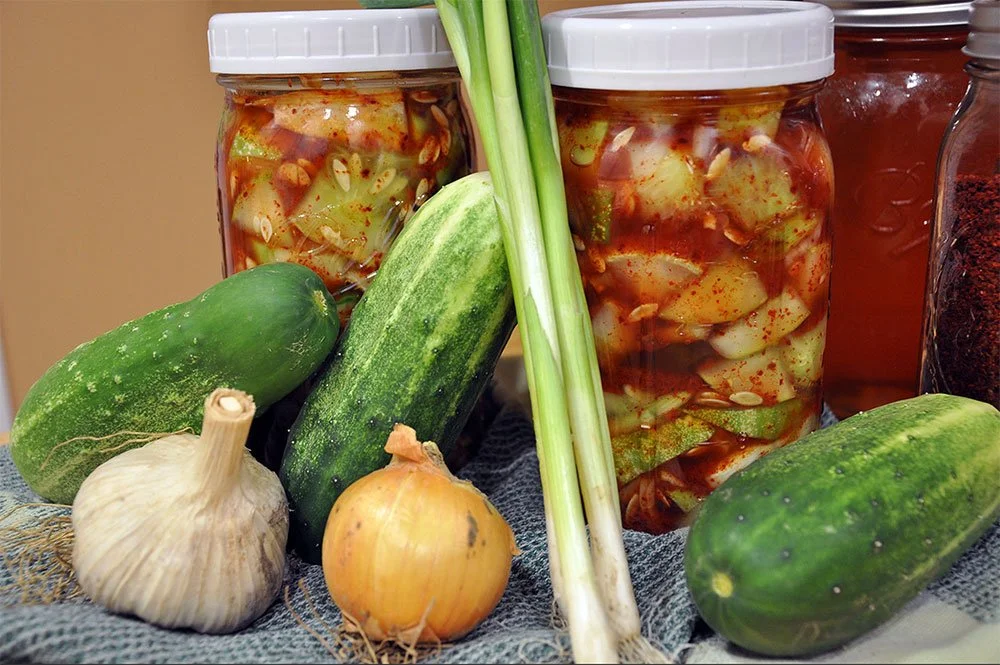Cucumber Kimchi
Time Frame: 1 day or longer
Easy to make and fermented within a day, cucumber kimchi stays crispy for a couple weeks in the refrigerator — if you can resist eating it all before then!
The combination of hydrating vegetables, mineral-rich brine, and active fermentation creates a refreshing, gut-friendly food that supports everything from blood sugar balance to immune health — with traditional flavor and minimal prep.
Ingredients
15 small cucumbers, or 5 large cucumbers
2 tbsp sea salt
3 bunches scallions or substitute similar ratio of any onion
2 tbsp garlic minced
1 tsp apple cider vinegar
1 tbsp honey
2 tbsp gochugaru Korean red chili flakes
optional: 2 hot red chilies
Supplies
large mixing bowl
mason jars
canning funnel (optional)
Method
1. Wash cucumbers. Peel and remove seeds (to reduce lectins), and chop into bite-sized pieces.
2. Sprinkle with 2 tbsp sea salt and mix thoroughly in a large bowl. Allow to sit for at least 2 hours at room temperature.
3. Chop scallions, mince garlic, and optional chili peppers. Blend in brined cucumbers.
4. Mix in honey, vinegar, and gochugaru. If your hands are sensitive to the hot spices, wear silicone gloves. Drain excess brine into a separate bowl.
5. Pack mixture in jars tightly. If water from cucumbers does not rise to cover the surface, top it with the reserved brine.
6. Cap jars and let ferment at room temperature for one day, opening it to off gas pressure periodically. Store in the refrigerator and serve chilled.
Functional Nutrition Benefits
1. Hydration + Electrolyte Support
Cucumbers are mostly water and rich in naturally occurring electrolytes like potassium, magnesium, and calcium — all of which support hydration, nerve signaling, and muscle function. The addition of sea salt in fermentation helps maintain mineral balance and aids cellular hydration, especially in warmer months or for those following low-carb diets.
2. Lectin Reduction Through Fermentation
Fermentation significantly reduces lectins and other anti-nutrients found in raw cucumbers and alliums. This makes the kimchi easier to digest and more suitable for individuals with lectin sensitivity or compromised gut function. Lactic acid bacteria break down these compounds during the fermentation process, enhancing digestibility and nutrient availability.
3. Gut-Supportive Probiotics
Just one day of fermentation creates an active culture of lactic acid bacteria (LAB) — the same beneficial microbes found in traditional kimchi, yogurt, and other cultured foods. These microbes:
Support microbial diversity
Enhance digestion
May improve immune resilience and mood through the gut-brain axis
4. Blood Sugar Balance from Fermented Fiber
Cucumbers and scallions provide prebiotic fibers, which feed beneficial gut bacteria and help modulate post-meal blood glucose.
5. Rich in Antioxidants & Anti-inflammatory Compounds
Gochugaru (Korean red chili flakes) and garlic are rich in antioxidants, including allicin and capsaicin, which support immune function and reduce inflammation.
Onions and scallions contain quercetin, an anti-inflammatory flavonoid linked to cardiovascular and immune health.
The bright color of the finished kimchi reflects the presence of these protective phytonutrients.
6. Digestive Enzyme Activity
The fermentation process creates natural digestive enzymes, such as amylase and lipase, which help the body break down starches and fats more efficiently. Adding even a small scoop of kimchi to meals can stimulate stomach acid and enzyme production — ideal for sluggish digestion or those transitioning off processed foods.
7. Culinary Versatility for Daily Use
This cucumber kimchi it’s a functional condiment that can:
Replace pickles on burgers or bowls
Add crunch and probiotics to salads
Support digestion when served with heavier meals (like meats or legumes)
